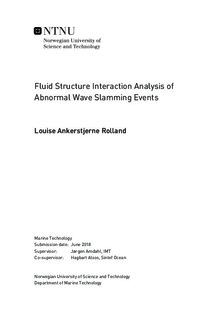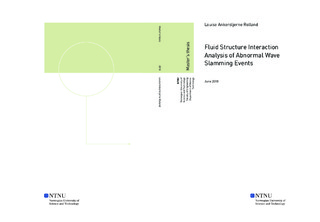| dc.description.abstract | In critical sea states, slamming wave loads may cause severe structural damage to marine
structures. The slamming loads are associated with fluid-structure impacts with high pressures and short durations. The structural components subjected to the abnormal slamming
loads may undergo large plastic deformations.
Previous model tests of slamming impacts have focused on the elastic structural response,
or the pressure variation on rigid structures. There is a lack of experimental data for elastoplastic response with large deformations. Experimental data is crucial for verification of numerical simulations and theoretical models. In this master thesis, a combination of experimental, numerical and theoretical methods has been applied to investigate abnormal wave
slamming events. Drop tests with a panel that falls though air and impacts the water have
been used to represent the slamming phenomenon. Drop tests of unstiffened aluminium plates have been performed in the Ocean Basin Laboratory and simulated in the finite element software LS-Dyna. The drop tests were performed at different drop heights with a deadrise angle of 0 or 4 degrees. Drop tests with identical impact conditions had a small scatter in the displacements and the the deformation pattern of
the plate. Digital image correlation, henceforth DIC, was used to measure the instantaneous
response of the plate field during the impact. Although the DIC technique had previously
not been applied to the fluid-structure interaction problem, the DIC measurement was successful. The simulations of the experimental drop tests in LS-Dyna compared well with the DIC measurements. The response coincided well during the first part of the impact, but the numerical simulations did not exhibit the same elastic recovery in the plates as measured by DIC. In conclusion, LS-Dyna has proven to be an useful tool for the simulation of the slamming impact event. Simplified methods were applied to establish the resistance curve and the maximum plate deflection due to slamming loads on a stiffened steel plate. The simplified resistance curves underestimated the deformation capacity of the plate for materials with hardening and large membrane effects. The estimation of the maximum response from established engineering practice agreed well with the numerical estimations from LS-Dyna. In conclusion, the simplified methods were useful for quick assessments of the capacity and response of the
stiffened panel, but should be validated with numerical simulations and, if available, experimental
data | |

